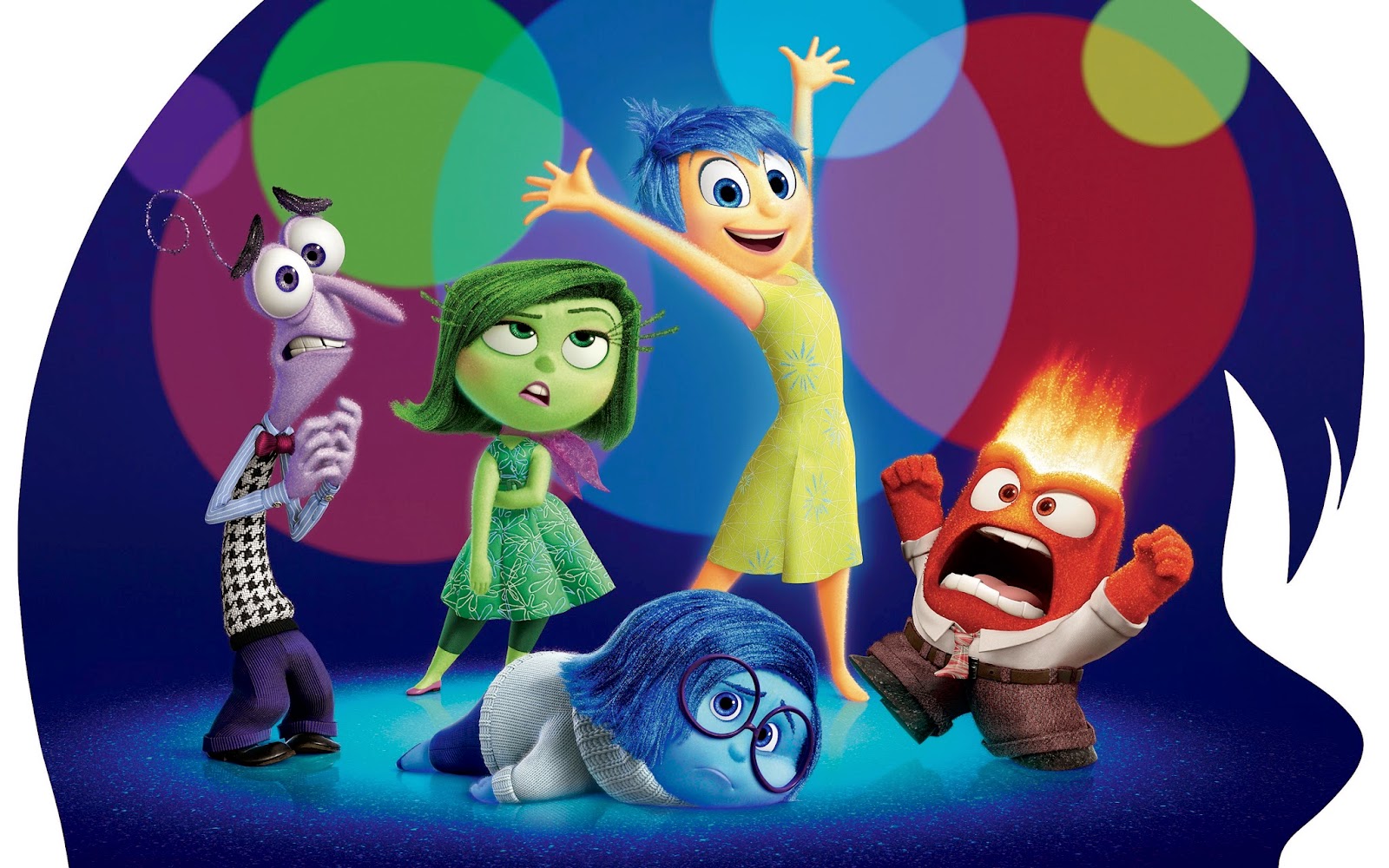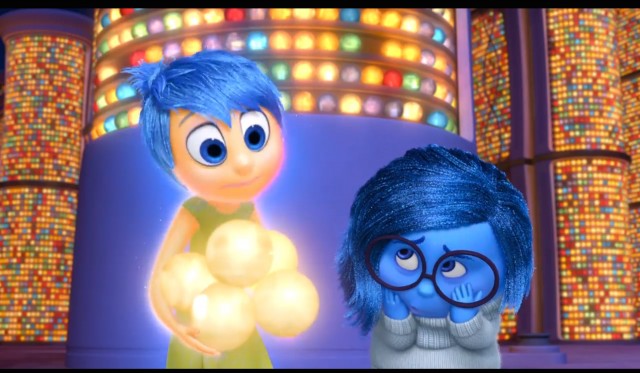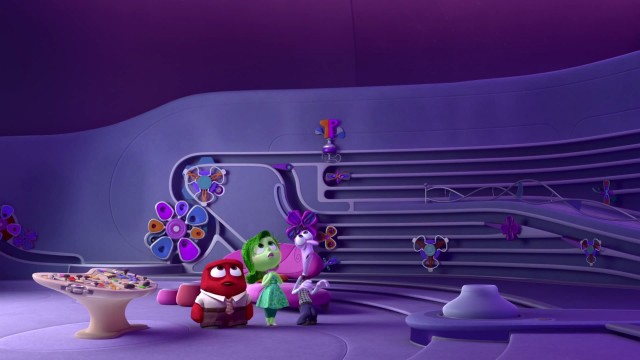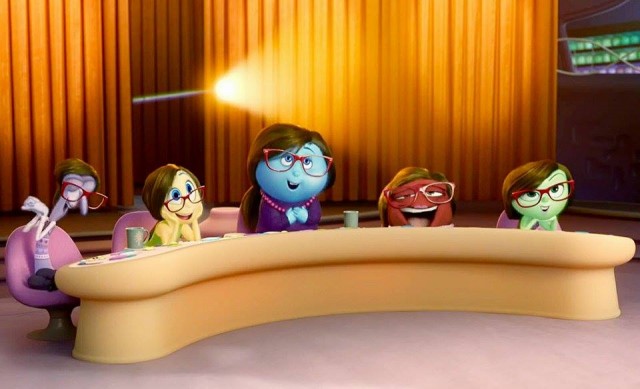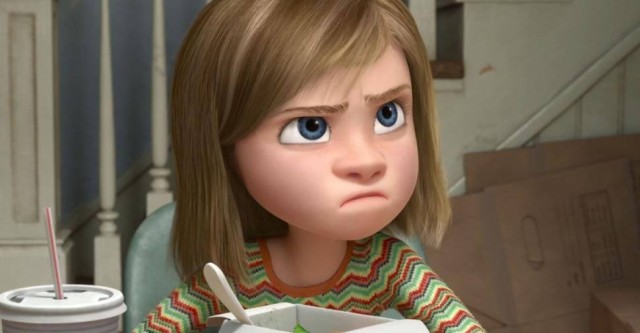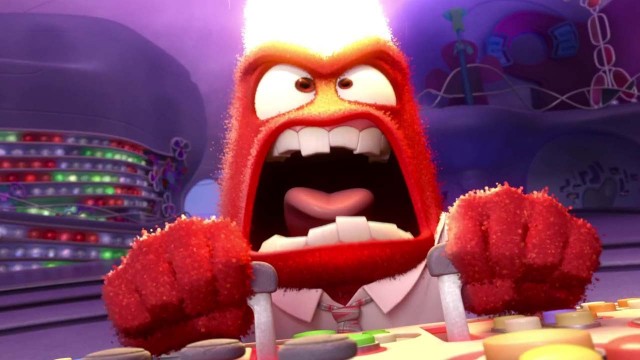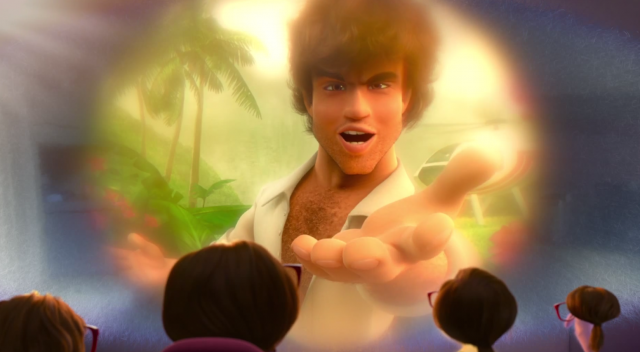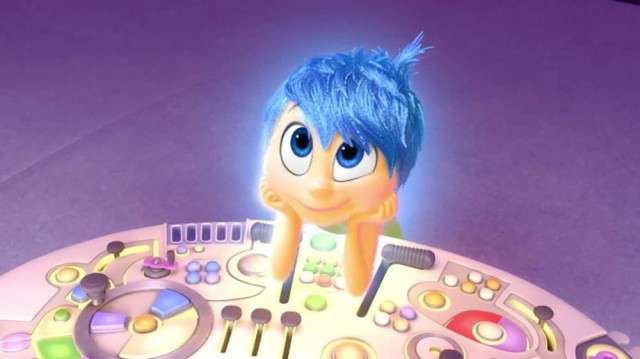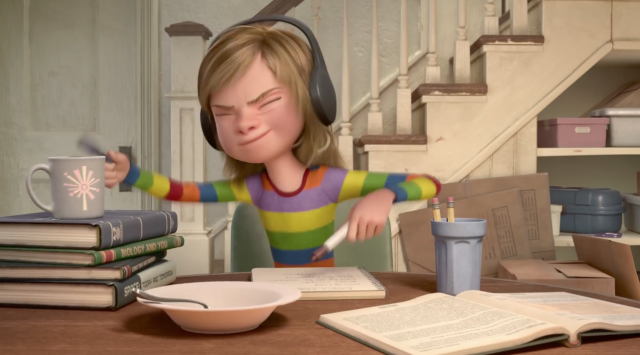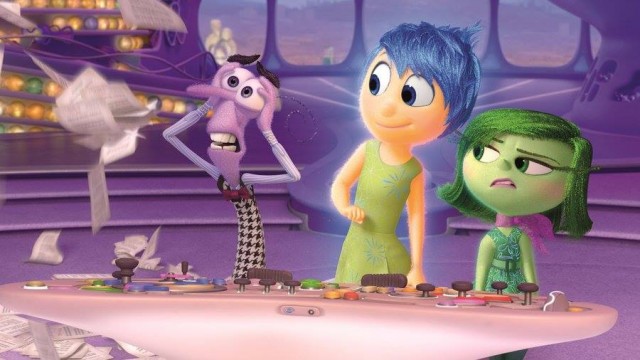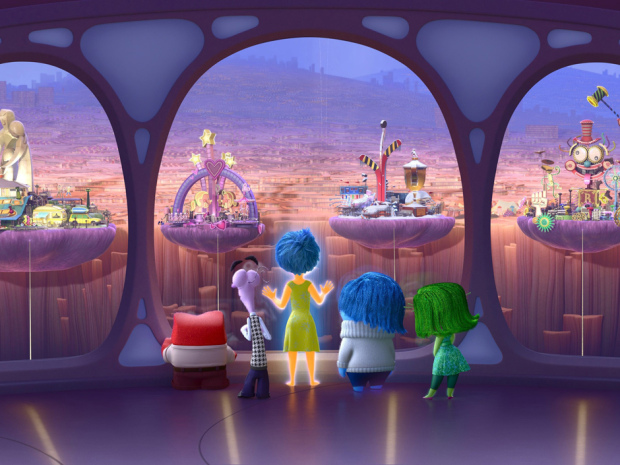Ever since shattering expectations with Toy Story 3 at the start of the decade, it seemed that Pixar strangely lost their way. After the horrendously superfluous Cars 2 in 2011. the strangely disappointing Brave in 2012, and the good, but largely unmemorable Monsters University in 2013, things really came to a head when Pixar’s planned 2014 project, The Good Dinosaur was entirely scrapped and re-shot with new actors, now placed for a revised release at the end of this year. Yikes. Things really weren’t looking good for the studio by the halfway point of the 2010’s, with rival animation outfit, Dreamworks Animation seeming to entirely steal their spotlight lately.
That gloomy recent history is why it’s especially satisfying to finally get a movie like Inside Out, which signals the long overdue comeback of Pixar, with what could very well be this Summer’s top family-friendly movie hit. Boasting an outstanding concept, an emotional, highly fulfilling storyline about the pains of growing up, and a whole lot of lovable Pixar charm and imagination, Inside Out will remind you why you fell in love with Pixar, while also tugging at your heartstrings with its adorable take on emotion and anxiety.
This may sound like a heavy movie for child viewers, but rest assured that even small children are perfectly safe to take to Inside Out, which will nonetheless entertain them with lively imagery and bright colours, while hopefully providing them some advance comfort when they reach the tender age of eleven-year-old protagonist, Riley. Even then though, it’s adults who have already grown up that will probably take the most from Inside Out, particularly those who have children of their own, as the movie does such an excellent job of spotlighting struggles that most adults would have long forgotten, and yet does so in such a way that illustrates why we’re nonetheless better people for said struggles.
Inside Out boasts two sets of protagonists, depending on where you’re looking, and it does well at showcasing both of them, without feeling like one or the other is getting the shaft. As mentioned, human protagonist, Riley is one of the leads, having moved to San Francisco with her parents at eleven years old, after her father gets a job with a California upstart company. On account of having to leave her friends, familiar surroundings, and the hockey team that she loved to play on, Riley is naturally not taking the move well, particularly as her parents become absorbed in trying to keep their new situation stable, and trying to make do with ending up in a small, dirty and uncomfortable new house, complete with a lost moving van.
Aside from Riley, the other set of leads is inside Riley’s head, specifically, the five core emotions that govern her thoughts and impulses. These consist of the extra colourful and energetic Joy, voiced by Amy Poehler, the shiftless, yet curious Sadness, voiced by Phyllis Smith, the neurotic, detail-oriented Fear, voiced by Bill Hader, the brash, no-nonsense Anger, voiced by Lewis Black, and the spoiled, snobby Disgust, voiced by Mindy Kaling. Riley may be the center of the story, but it’s her emotions that push it forward, and add the many fantastic working parts atop the sound foundation.
The way that the characters’ individual struggles complement each other is sublime. Each has a direct effect on the other, with Riley’s situation altering the core personality of her mind, which physically manifests itself as an ever-changing landscape, and all the while, the actions of her emotions attempting to control the situation alter Riley’s behaviour further, often to negative effect.
Things really kick up when Sadness and Joy are inadvertently sucked away from the other emotions, leaving Fear, Anger and Disgust to dictate Riley’s behaviour exclusively. Naturally, this only makes Riley’s life more difficult, while Joy and Sadness, two polar opposite emotions, have to try and get along and work together well enough so that they can get back to the others, after becoming lost in Riley’s long-term memory. Along the way, they encounter things like imaginary friends, the world of dreams, and everything else that Riley is moving on from as she becomes a tween.
It’s something of a miracle that Inside Out can view such an ugly time of growing up through what’s honestly a very charming and colourful lens. The movie is jam-packed with heart, and that’s what makes its subject matter work so brilliantly. As surreal as this interpretation of a human mind is, it’s real enough to make everything hit home for the adult viewers who are old enough to appreciate what’s going on. True to form, Riley’s parents feel like footnotes in the background, despite the reasonable billing of her mother being voiced by Diane Lane and her father being voiced by Kyle Maclachlan, as Riley’s rupturing psychology appears to consume her more and more. This makes sense, as the audience is so rarely able to pay attention to background characters, but that’s the idea. When you’re struggling like Riley is, everything else feels like background noise, even when it should matter.
It also helps that the voiceover work is excellent as well. Each actor for the major emotions in particular is perfectly chosen, and they contribute a large part of the comedy to the movie, while Riley herself saddles more of the drama. The emotions perceive drama as well at times, but the inside workings of Riley’s head are where most of the charm lies. Seeing the emotions wander into the uncharted territory of Riley’s subconscious and more abstract thinking centers is worth the price of admission alone simply for Amy Poehler’s and Phyllis Smith’s amazing voice work, just as seeing how an arguing Bill Hader, Lewis Black and Mindy Kaling make everything worse in creative, yet still humourous ways, despite their best intentions.
Without spoiling anything, Inside Out also brings everything together with a result that you won’t expect, but one that still shows how, no matter how difficult growing up can be, you’re not in it alone. Just as Joy and Sadness must learn to be a team, audiences are reminded that the best thing one can do for others in times of difficulty is band together and simply be there for each other. Sometimes, that’s enough to find answers.
Mind you, Inside Out’s journey is not one without real stakes, and sometimes even real loss and grief, which is easily felt by viewers, as the movie doesn’t pull punches with its harder material, despite the colourful, charming presentation. By the end however, the movie will still leave its characters in a place that will warm the hearts of audiences both young and old.
Inside Out’s plot is very, very simple, and yet amazingly complex in scope. It’s that kind of exceptional inspiration that makes the movie very easy to grasp for young children, but also offers something extra special and heartfelt for adults who have already had the experiences it’s taking after.
You could simply sum up the movie as the ups and downs of a tween girl moving to a new home, and having to cope with her new surroundings, as the colourful emotions in her head do the same. That would be valid. It would also be valid however to describe the movie as a complex tale of angst, heartbreak, grief and perhaps even mental degradation, as a girl’s mind comes apart amidst the wrong brand of stimulus, if you wanted to be dark and deep about it.
No matter how you view Inside Out however, you’re sure to see it as a masterpiece of family-friendly storytelling, right up there with the kind that Pixar delivered throughout most of the 2000’s. It’s an emotional story, and the emotions and struggles behind everything are very real, especially for adult viewers, but Inside Out is still ultimately a feel-good story, even if not every scene will leave you feeling good. The cocktail of emotions is stirred in such a way to be thought-provoking without compromising the charm however, and even as our own impulses of sadness and anger may be poked at in certain scenes, everything is balanced out by the end, leaving audiences satisfied that they’ve seen a well-crafted Pixar story that allows people to re-interpret the world and each other not only in a different way, but in a better way.
Most of Inside Out is the brain-child of Pete Docter, who previously helmed two of Pixar’s all-time best offerings from the 2000’s, Monsters Inc. and Up, along with doing story treatments for three out of the four Toy Story movies, save for Toy Story 3. Docter co-directs Inside Out alongside Ronaldo Del Carmen, who was an art director that originally worked for Warner Bros., namely in overseeing the art direction for several animated projects from DC Comics. He even did a couple of art direction jobs for Dreamworks Animation in their pre-CG days, before being hired by Pixar to do storyboarding for both Ratatouille and Up beforehand. That resume is quite ironic, as Del Carmen worked for both Disney’s and Pixar’s main rivals, before finding his current niche.
Docter oversees the character interaction and storytelling behind the movie, while Del Carmen seems to be in charge of how the physical manifestations of Riley’s mind are portrayed. Both men work together brilliantly here, and they produce a work that feels like it exists both within and separately from the real world, without missing a beat. As fantastical and fun as Inside Out can be, the movie feels grounded in a real place, which makes its comedy and drama realized all the more effectively.
You can also tell that the co-directors work exceptionally with the voice actors as well, as Inside Out delivers some of the best and most memorable voice acting in Pixar’s history, probably since the original Toy Story. Inside Out has quite a few writers, with Docter and Del Carmen also contributing to the script themselves, yet despite that, the movie never feels confused or over-stuffed. Generally, the seven writers credited with Inside Out’s story would be a red flag, though it’s delegated well, with three dedicated screenwriters expanding upon the initial story template by Docter and Del Carmen, and Amy Poehler and Bill Hader being credited as injecting some added comedic dialogue into the script.
Inside Out is a fantastic directing achievement for both of its co-helmers, since they could have easily stepped on each other’s toes, particularly with the huge amount of moving parts having to come together in this movie, spread across two disparate realities to boot. Instead, as Pixar does when they’re on their A-game, they make the line between reality and fiction easily dance to their tune, creating something incredible that satisfies from every conceivable angle.
Michael Giacchino composes the soundtrack to Inside Out, reuniting with Pete Docter as composer after Up in 2009. Giacchino’s score is once again superb, mirroring the emotion behind events, rather than trying to accentuate events themselves. Instead, the score allows the movie’s visuals and dialogue to tell the story, only stepping in when it needs to, to help provide a light, but perfectly-executed touch only when necessary.
The movie’s soundtrack is often quiet and understated in the outside world with Riley, but in Riley’s head, everything sounds louder and much more imposing. This is a subtle, but very inspired audio choice, reflecting how our own perceptions and experiences seem much more potent to us than they often do to others. Something as quick and quiet as an emotional shift is undetectable to fellow humans that surround Riley in the outside world, but in Riley’s mind, these reactions sound through the theatre as violent earthquakes or sudden power outages, sometimes with the very ground being torn asunder as every impulse gives way to a potentially violent change in scenery.
The way that the audio is implemented into the movie is remarkably clever, and yet still never aiming to override the visuals or the story. Instead, it provides another complement to it, often being as chaotic, and yet as reasonable as the human mind itself can often be, at least within our own heads.
Inside Out is colourful without being flashy, and well-rendered without being obnoxious. It’s another great animation job from Pixar, with the mundane human world offset by the more fantastical emotional centers of Riley’s mind. It’s no surprise that Riley’s mind is the most creative visual point of the movie, with some of its surprise turns bending Pixar’s animation department in ways that you probably wouldn’t have imagined before!
The animation highlight in the movie however is definitely Riley’s five core emotions themselves, which are packed with neat little details. The way that each emotion sparkles as something of a manifestation of raw mental energy is very cool, and subtle touches like Joy glowing when she gets excited are very neat. Likewise, each of the emotions have very inspired visual designs that echo some of Riley’s tastes, such as Fear resembling a raw nerve ending, and Disgust being similar to broccoli, a vegetable that Riley hates. The most noticeable and amusing however is probably Anger’s flaming head, which erupts whenever he’s set off.
I saw Inside Out in 3D as well, and it was acceptable, though nothing special in that format. Pixar still doesn’t seem to want to embrace 3D on the same level as their main competitors like Dreamworks Animation, Blue Sky Studios or Illumination Entertainment, and Inside Out continues to keep the 3D pretty understated. There are a handful of 3D effects that appear to pop out of the screen every now and again, but not very blatantly. Most of the 3D is done to enhance the atmosphere, namely in making Riley’s mind feel larger and more expansive during the wide, sweeping views of it. The small enhancements are good enough to merit a 3D viewing if you prefer to watch movies in that format, but if you’d rather watch Inside Out flat in 2D, you’re really not missing much.
Regardless of whether you see it in 3D or 2D however, Inside Out is still a visual marvel, particularly in how it brings together several varieties of art direction that shouldn’t go together, and yet somehow, they do. Even during their slump from the past several years, Pixar has at least kept sharp in the animation department however, and that remains more true than ever with their latest big screen offering.
Inside Out signals the triumphant return of Pixar after several problematic years, and has now rocketed up to being one of this Summer’s most recommendable movies, for viewers of any age. It’s an ambitious project, but one that’s realized brilliantly, with the same unbeatable heart and charm that it seemed like Pixar couldn’t replicate after their low point of Cars 2. Fortunately, a return to form comes better late than never, and it’s all the better that we’ve found one in a movie as excellent as Inside Out.
The movie, in true Pixar fashion, doesn’t shy away from some difficult material, as adults will find a story that’s far more challenging and deep than most other family-friendly movies. Kids however will be nonetheless entertained by the lovable and well-realized core emotions in Riley’s mind, along with the inviting world that they inhabit. Inside Out is rooted in a surprising degree of modern psychological accuracy too, so even when it gets weird, it never fully escapes the grip of reality. That shouldn’t matter to kids though, who will simply be amused by the well-executed plotline and highly charming animation.
For kids and adults alike, I simply can’t recommend Inside Out enough! It delivers the kind of outstanding animated masterpiece that demands to be seen by anyone, one that wraps a challenging and emotionally complex storyline with a comforting blanket of optimism and vibrancy. The fact that it’s also exceptionally creative, incredibly fun, and perfectly satisfying is icing on the cake.
Good to have you back, Pixar!

